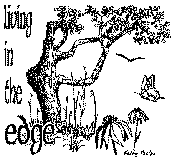
| Great Lakes Ecosystems | ||

|
|
|||||||||
|
1994
Proceedings
| ||||||||||||||||||||||||||||||||||||||||||||||||||||||||||||||||||||||||||||||||||||||||||||||||||||||||||||||||||||||||||||||||||||||||||||||||||||||||||||||||||||||||||||||||||||||||||||||||||||||||||||||||||||||||||||||||||||||||||||||||||||||||||||||||||||||||||||||||||||||||||||||||||||||||||||||||
|
BURR OAK SAVANNA TO SUGAR MAPLE FOREST: HISTORIC AND CURRENT VEGETATION PATTERNS IN THE FUNKS GROVE NATURAL AREA Bradley J. Arnold |
 |
The Funks Grove Natural Area is located in Southwest McLean County in Funks Grove township, nine miles southwest of Bloomington, in sections 16, 17, 18, 19, and 20, T. 22N., R. 1 E., 3rd P.M. At the time of European settlement, the Township was mostly prairie with timber occurring in groves along streams (Hutchison and Johnson 1981).
Today, the Natural Area occurs in one of the original prairie groves and is dominated by shade-tolerant tree species, predominately sugar maple and is a closed forest. However, in a portion of the natural area, the occurrence of large open-grown burr oaks, which are scattered throughout the area, suggests that it was probably open savanna in pre-European settlement times.
Government Land Office records were used to reconstruct pre-European settlement vegetation patterns of the natural area. Witness trees were recorded at each section division and some 1/4 section intersections. Using modifications of the Point Centered Quarter Method, each point was placed into a vegetation category based on an estimate of tree density (trees/ha) at that point. The following categories were used: Closed forest = > 39 trees/ha, Open Forest = > 19 but < 39, Savanna = > 0.2 but < 19, and Prairie = 0 - 0.2 trees/ha.
The portion of the natural area with the large open-grown burr oaks, located in the NW 1/4, of the NW 1/4, of section 20, was sampled in 1977 and in 1994. A set of three nested circular quadrats were used to sample the area at ten points which were located using a stratified random sampling procedure.
Trees (stems > 9.0 cm DBH) were sampled in a 0.04 ha quadrat, saplings (stems > 1.0 but < 9.0 cm DBH) and seedlings (stems > 15 cm tall but < 1.0 cm DBH) were sampled in 0.01 and 0.004 ha quadrats, respectively. The data were analyzed to determine density (stems/ha) and dominance (m2/ha), relatively density, relative dominance, and an importance values (Rel. Density + Rel. Dominance/2) for tree species. For seedlings and saplings, density and relative density were computed.
The reconstructed pre-settlement vegetation of Funks Grove indicated the grove was surrounded by prairie and had a fringe of savanna and open forest. Closed forest was most extensive on the east side of Timber Creek, the major drainage system through the Natural Area.
Sugar maple was a dominant tree species in the 1977 and 1994 samples; however, its importance value increased from 16.6 in 1977 to 57.7 in 1994 (Tables 1 and 2). In 1977, American elm was the most important tree species. However, it occurred only in the smaller tree size classes. American elm was not sampled in 1994. Burr oaks were few in number but were large (DBH = 41.4 to 131 cm). The largest burr oaks were probably remnant trees from the pre-European settlement savanna. Burr oak is not successfully reproducing, which is the case for all shade intolerant canopy dominants. In contrast, sugar maple is well represented in seedling, sapling, and small, medium size tree classes.
Prior to settlement by Europeans, 5.4% of McLean County was savanna (Rodgers and Anderson 1979). Fire is a major cause for the presence of savannas as well as prairie. Savannas represent transitional areas between forest and prairie, but savannas burned less frequently than prairies.
The burr oaks in Funks Grove have an open growth form, with large branch scars, indicating that the study area was at one time open savanna. The thick bark of burr oak trees enabled them to withstand periodic fires.
Following settlement by Europeans, fires ceased and the shade tolerant and fire sensitive tree species increased in abundance. In recent years, the changes in species composition in forests dominated by oak in the canopy is apparent. In many areas, the only oaks are those which were established before sugar maple invasion. As a result of fire cessation, which favors sugar maple, many of the last remnants of our native savannas are disappearing.
Hutchison, M. D. and M. Johnson. 1981. The natural features of Funks Grove Natural Area in McLean County, Illinois. Unpublished Report. Illinois Nature Preserves Commission and Natural Land Institute. Rockford, IL.
Rodgers, C. S. and R. C. Anderson. 1979. Presettlement vegetation of two prairie peninsula counties. Botanical Gazette 140: 232-240.
Table 1. Tree, sapling and seedling data for the 1977 sample of Funks Grove Natural Area.
| TREES | DENSITY | DOMINANCE (BA) | |||
| Species | #/ha | Rel Den | m2/ha | Rel Dom | IV/2 |
| American Elm | 132.5 | 44.9 | 3.6 | 13.1 | 29.0 |
| Sugar Maple | 55.0 | 18.6 | 4.0 | 14.5 | 16.6 |
| Red Elm | 37.5 | 12.7 | 1.9 | 6.9 | 9.8 |
| White Ash | 22.5 | 7.6 | 6.6 | 24.0 | 15.8 |
| Hackberry | 12.5 | 4.2 | 1.1 | 4.0 | 4.1 |
| Blue Ash | 10.0 | 3.4 | 1.8 | 6.5 | 5.0 |
| Burr Oak | 5.0 | 1.7 | 6.7 | 24.4 | 13.1 |
| Shagbark Hick. | 5.0 | 1.7 | 0.08 | 2.9 | 2.3 |
| Black Cherry | 5.0 | 1.7 | 0.1 | 0.4 | 1.1 |
| Black Walnut | 2.5 | 0.9 | 0.4 | 1.5 | 1.2 |
| Chinquapin Oak | 2.5 | 0.9 | 0.4 | 0.4 | 0.7 |
| Basswood | 2.5 | 0.9 | 0.1 | <.1 | 0.5 |
| Box Elder | 2.5 | 0.9 | <.1 | <.1 | 0.5 |
| TOTALS | 295 | 100.1 | 27.5 | 100.3 | 100.4 |
| SAPLINGS | ||
| Species | #/ha | Rel Density |
| Sugar Maple | 780 | 59.1 |
| Hackberry | 160 | 12.1 |
| American Elm | 150 | 11.4 |
| Paw Paw | 100 | 7.6 |
| Blue Ash | 80 | 6.1 |
| Red Elm | 30 | 2.3 |
| Kentucky Coffee | 10 | 0.8 |
| Yellow-Bud Hickory | 10 | 0.8 |
| Totals | 1320 | 100.2 |
| SEEDLINGS | ||
| Species | #/ha | Rel Density |
| Paw Paw | 300 | 27.3 |
| Blue Ash | 225 | 20.5 |
| Box Elder | 200 | 18.2 |
| Sugar Maple | 175 | 15.9 |
| Burr Oak | 75 | 6.8 |
| Hackberry | 50 | 4.6 |
| Shagbark Hick. | 25 | 2.3 |
| Yellow-Bud Hick. | 25 | 2.3 |
| Unknown Oak | 25 | 2.3 |
| TOTALS | 1100 | 100.2 |
Table 2. Tree, sapling and seedling data for the 1994 sample of Funks Grove Natural Area.
| TREES | Density | Dominance (BA) | |||
| Species | #/ha | Rel Den | m2/ha | Rel Dom | IV/2 |
| Sugar Maple | 150.0 | 74.1 | 11.8 | 41.3 | 57.7 |
| Burr Oak | 15.0 | 7.4 | 8.7 | 30.4 | 18.9 |
| Blue Ash | 7.5 | 3.7 | 1.5 | 5.2 | 4.5 |
| Hackberry | 0.5 | 2.5 | 2.0 | 7.0 | 4.8 |
| White Ash | 5.0 | 2.5 | 1.4 | 4.9 | 3.7 |
| Red Elm | 5.0 | 2.5 | 1.0 | 3.5 | 3.0 |
| Shagbark Hick. | 5.0 | 2.5 | 0.6 | 2.1 | 2.3 |
| Chinquapin Oak | 2.5 | 1.2 | 1.2 | 4.2 | 2.6 |
| Basswood | 2.5 | 1.2 | 0.3 | 1.0 | 1.1 |
| Ironwood | 2.5 | 1.2 | 0.1 | 0.3 | 0.8 |
| Paw Paw | 2.5 | 1.2 | <.1 | <.1 | 0.6 |
| TOTALS | 202.5 | 100.0 | 28.6 | 99.9 | 100.0 |
| SAPLINGS | ||
| Species | #/ha | Rel Density |
| Sugar Maple | 890 | 88.1 |
| Paw Paw | 100 | 9.9 |
| Hackberry | 10 | 1.0 |
| Hawthorn | 10 | 1.0 |
| Totals | 1010 | 100.0 |
| SEEDLINGS | ||
| Species | #/ha | Rel Density |
| Paw Paw | 1275 | 53.1 |
| Sugar Maple | 625 | 26.0 |
| Red Elm | 450 | 18.8 |
| Blue Ash | 25 | 1.0 |
| Hackberry | 25 | 1.0 |
| TOTALS | 2400 | 99.9 |